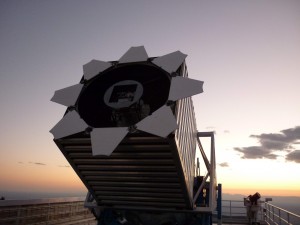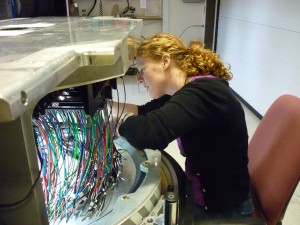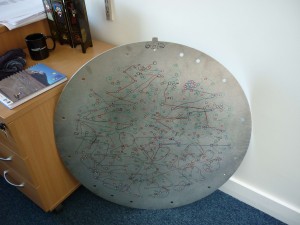MaNGA plate at Fife Doors Open
Shine is back after a break over the summer! We are now in full preparation for our big science, music and art festival in the Byre Theatre on 7 November, and in the upcoming weeks we will use this blog to show you some of the activities that we have in mind.

Today, let’s talk about observing galaxies. Our very own Dr. Anne-Marie Weijmans is the lead observer for MaNGA, which has nothing to do with Japanese cartoons, but everything with obtaining as much information as we can about nearby galaxies. MaNGA stands for Mapping Nearby Galaxies at Apache Point Observatory, which is a telescope site in New Mexico, US. APO is home of the 2.5-meter Sloan Telescope, and although this is a modest size for a telescope (the big ones in Hawaii and Chili have mirrors up to 8 meter in diameter!), the Sloan Digital Sky Survey is one of the most successful surveys in astronomy.
The Sloan Telescope first took images of a very large part of the northern sky, and then was equipped with a spectrograph, to unravel the light of galaxies in different wavelengths. This allowed astronomers to determine the composition and velocities of stars and gas in galaxies, learning more about the way that these galaxies formed. Now, the Sloan Digital Sky Survey measures properties of stars in the Milky Way (APOGEE survey), determines the cosmic expansion rate by measuring very accurate positions of far away galaxies (eBOSS survey), and maps nearby galaxies with MaNGA. How do they do that?

The answer is by using a very sophisticated and effective observing strategy, using plates. These plates are drilled in Seattle, using a very precise process. We start with an aluminum plate, and at each galaxy or star position, a hole is drilled. The plates are then shipped to APO, where a team of plate pluggers plugs one fiber into each hole. Each fiber goes to the spectrograph, so that when the observers during the night attach the plate to the telescope, the astronomers get a spectrum for each galaxy or star.

The Sloan Digital Sky Survey has some great movies on YouTube, that show you the drilling process, plugging, and night observing (click on the links to see the movies). And at Shine we are very lucky to have one of these plates in our possession: we have a very rare MaNGA plate, that was drilled for a test-run in January 2013, when MaNGA was still in its development phase. Anne-Marie spent 3 weeks at the APO mountain top that winter, to get all the test data in place.
Want to see this plate, and talk to Anne-Marie about her experience with observing galaxies with MaNGA? Then come this Sunday 6 September to Anstruther, where artist Tim Fitzpatrick has opened the doors of his studio for Fife Doors Open. Our MaNGA plate will be on display, and astronomer Kirstin Hay will also be there with a cosmic floor keyboard, where you can step along the expanding Universe. We’re at Murray Studios, 21 Cunzie Street, between 14:00 and 17:00.
